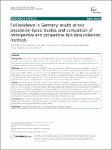Fall incidence in Germany: results of two population-based studies, and comparison of retrospective and prospective falls data collection methods
Rapp, Kilian
Freiberger, Ellen
Todd, Chris
Klenk, Jochen
Becker, Clemens
Denkinger, Michael
Scheidt-Nave, Christa
Fuchs, Judith
Background: Fall incidence differs considerably between studies and countries. Reasons may be differences between study samples or different assessment methods. The aim was to derive estimates of fall incidence from two population-based studies among older community-living people in Germany and compare retrospective and prospective falls data collection methods. Methods: Data were derived from the 2008–11 wave of the German health interview and examination survey for adults (DEGS1), and the Activity and Function of the Elderly in Ulm study (ActiFE-Ulm). Data collection took place in community facilities (DEGS1) or participants’ homes (ActiFE-Ulm). Participation rates were 42% (newly recruited) and 64% (panel component) in DEGS1 and 19.8% in ActiFE-Ulm. Self-report retrospective fall data covering the previous 12 month period in DEGS1 and ActiFE-Ulm were collected, but only ActiFE-Ulm used prospective 12 month fall calendars. The incidence of ‘any fall’ and ‘recurrent falls’ were calculated for both methods. Results: Fall rates increased with age in men but not women. The ActiFE-Ulm prospectively assessed incidence (95% confidence interval) in women and men aged 65-
Dateien zu dieser Publikation
Keine Lizenzangabe

